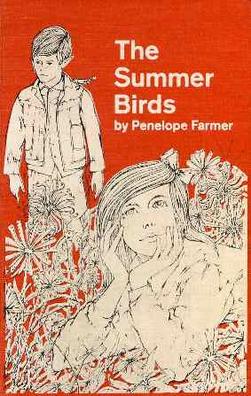The Summer Birds facts for kids

First edition
|
|
| Author | Penelope Farmer |
|---|---|
| Country | United Kingdom |
| Language | English |
| Genre | Children's novel |
| Publisher | Chatto & Windus (UK) Harcourt Brace (US) |
|
Publication date
|
1962 |
| Media type | |
| Followed by | Emma in Winter |
The Summer Birds is a children's book written by Penelope Farmer from Britain. It was first published in 1962 by Chatto & Windus. This book was recognized with a special mention for the Carnegie Medal. It's the first of three stories about two sisters, Charlotte and Emma Makepeace. These books are sometimes called the Aviary Hall series.
Contents
About the Book's Creation
Penelope Farmer was just 21 years old when she got a contract for her first collection of short stories. It was called The China People. While she was teaching in London, an editor asked her to write a children's book.
Farmer had a story that was too long for her short story collection. She decided to use this idea for her new book. This story became the first chapter of The Summer Birds. It was her first book about Charlotte and Emma Makepeace. The story takes place in a small village school. It is also set at Aviary Hall, the girls' home in the South Downs of southern England.
Farmer said that Charlotte and Emma were based on her mother and her mother's sister. They grew up without parents in their Grandfather Elijah's house. They had to rely on each other. One sister was responsible, and the other was a bit difficult.
What Happens in the Story
Charlotte and Emma Makepeace live with their grandfather, Elijah. Their home is a country house in the South Downs of southern England. The house is called Aviary Hall. It is decorated with stuffed birds and pictures of birds.
One day, on their way to their small village school, they meet a mysterious boy. He tells them he can teach them how to fly. Over the next few days and weeks, the boy teaches Charlotte to fly. Soon, all the other children at the school learn this amazing skill.
The boy remains invisible to adults. Only the schoolteacher, Miss Hallibutt, can see him. She had wished she could fly when she was a child. The boy tells her he can only teach children to fly.
The children spend a wonderful summer flying above their village. They soar over the beautiful downs. As summer starts to end, the boy offers to take the children on a journey. The children get ready to go with him.
Charlotte then realizes the boy is not telling them everything. She makes him tell the truth. The boy admits he wants to take them to his country. There, they could fly forever and stay children forever. They would never have adult worries. But, the cost of going with him is high. They would never be able to return home or see their loved ones again.
The children decide this is too big a price to pay. They all choose not to go with the boy. Only one girl, who has no parents or a happy home, decides to go. The other children return to their homes. They get ready to start a new school term.
Awards and Recognition
The Summer Birds received a special mention for the Carnegie Medal in 1963. It was also listed as an American Library Association Notable Book that same year.
Other Versions of the Story
In 1987, PBS Video released an educational video version of The Summer Birds. This video used narration, artwork, sound effects, and music. It helped introduce children to many featured children's books.
More Adventures: The Sequels
The Summer Birds is the first book in a series.
- A second book, Emma in Winter, came out in 1966. It takes place about a year and a half later. Emma is the main character in this story.
- Charlotte Sometimes was published in 1969. This story happens just before Emma in Winter. It follows Charlotte's first term at boarding school, about a year after the events in The Summer Birds.

